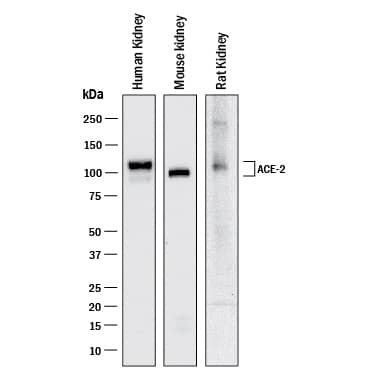Human IL-17D Antibody Summary
Ala18-Pro202
Accession # Q8TAD2
Customers also Viewed
Applications
Please Note: Optimal dilutions should be determined by each laboratory for each application. General Protocols are available in the Technical Information section on our website.
Scientific Data
 View Larger
View Larger
IL‑17D in Human Breast. IL-17D was detected in immersion fixed paraffin-embedded sections of human breast using Goat Anti-Human IL-17D Antigen Affinity-purified Polyclonal Antibody (Catalog # AF1504) at 15 µg/mL overnight at 4 °C. Tissue was stained using the Anti-Goat HRP-DAB Cell & Tissue Staining Kit (brown; CTS008) and counterstained with hematoxylin (blue). Specific labeling was localized to the cytoplasm of epithelial cells. View our protocol for Chromogenic IHC Staining of Paraffin-embedded Tissue Sections.
Preparation and Storage
- 12 months from date of receipt, -20 to -70 °C as supplied.
- 1 month, 2 to 8 °C under sterile conditions after reconstitution.
- 6 months, -20 to -70 °C under sterile conditions after reconstitution.
Background: IL-17D
The Interleukin-17 (IL-17) family proteins, comprising six members (IL-17, IL-17B through IL-17F), are secreted, structurally related proteins that share a conserved cysteine-knot fold near the C-terminus, but have considerable sequence divergence at the N-terminus (1, 2). With the exception of IL-17B, which exists as a non‑covalently linked dimer, all IL-17 family members are disulfide-linked dimers (3). IL-17 family proteins are pro-inflammatory cytokines that induce local cytokine production and are involved in the regulation of immune functions (1, 2). Two receptors (IL-17 R, and IL-17B R), which are activated by IL-17 family members, have been identified. In addition, at least three additional orphan type I transmembrane receptors with homology to IL-17 R, including IL-17 RL (IL-17 RC), IL-17 RD, and IL‑17 RE, have also been reported (1‑4). The functions of IL-17 RC, D, and E are not known.
Human IL-17D cDNA encodes a 202 amino acid (aa) residues protein with a putative 17 aa signal peptide (5). Human and mouse IL-17D share 78% sequence identity. Among IL-17 family members, IL-17D is most closely related to IL-17B, sharing 27% aa sequence homology (5, 6). IL-17D is expressed preferentially in skeletal muscle, heart, adipose tissue, lung, pancreas, and nervous system (1, 5). Like other IL-17 family members, IL-17D modulates immune responses indirectly by stimulating the production of myeloid growth factors and chemokines including IL-6, IL-8, and GM-CSF (5). IL-17D has also been shown to suppress the proliferation of myeloid progenitors in colony formation assays. The receptor of IL-17D has not yet been identified. However, stimulation of IL-8 production by IL-17D is mediated through the activation of nuclear factor kappa-B (5). The IL-17D preparations from R&D Systems have been found to bind immobilized recombinant IL17B R/Fc in a functional ELISA.
- Aggarwal, S. and A.L. Gurney (2002) J. Leukoc. Biol. 71:1.
- Moseley, T.A. et al. (2003) Cytokine & Growth Factor Rev. 14:155.
- Hymowitz, S.G. et al. (2001) EMBO J. 20:5332.
- Haudenschild, D. et al. (2002) J. Biol. Chem. 277:4309.
- Starnes, T. et al. (2002) J. Immunol. 169:642.
- Li, H. et al. (2000) Proc. Natl. Acad. Sci. USA 97:773.
Product Datasheets
FAQs
No product specific FAQs exist for this product, however you may
View all Antibody FAQsIsotype Controls
Reconstitution Buffers
Secondary Antibodies
Reviews for Human IL-17D Antibody
There are currently no reviews for this product. Be the first to review Human IL-17D Antibody and earn rewards!
Have you used Human IL-17D Antibody?
Submit a review and receive an Amazon gift card.
$25/€18/£15/$25CAN/¥75 Yuan/¥2500 Yen for a review with an image
$10/€7/£6/$10 CAD/¥70 Yuan/¥1110 Yen for a review without an image











